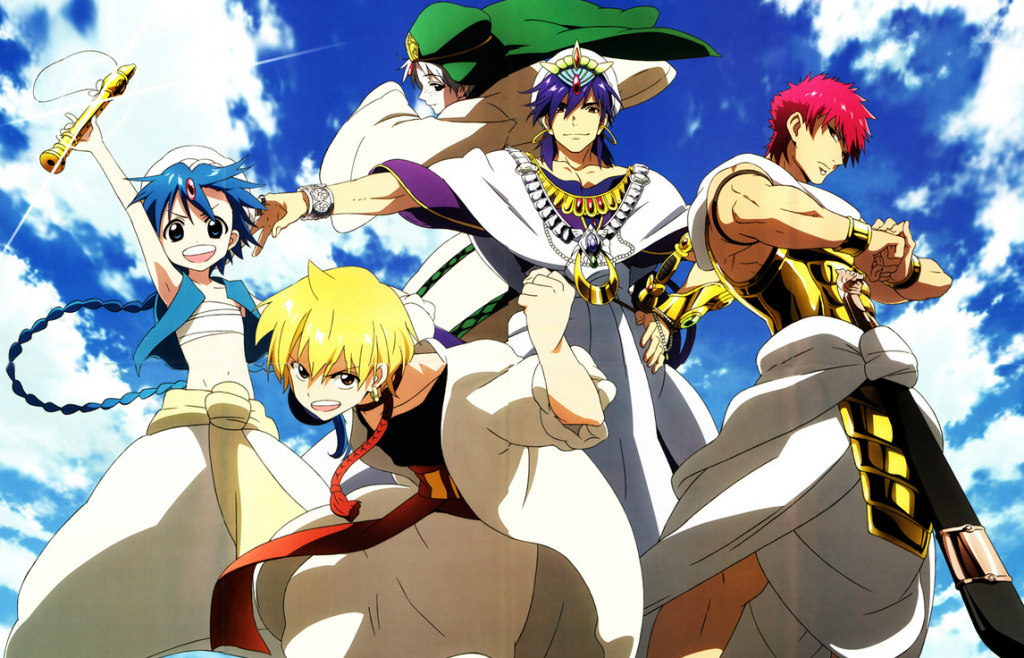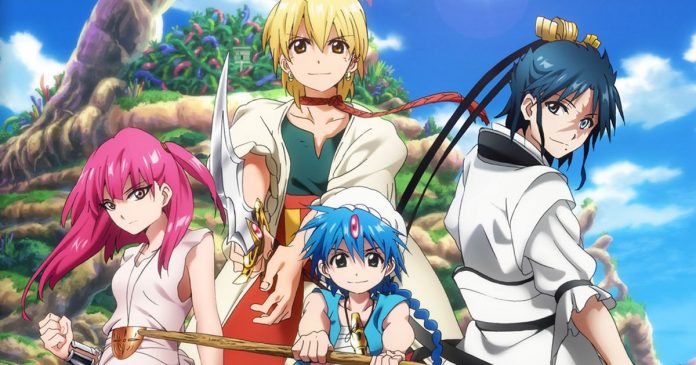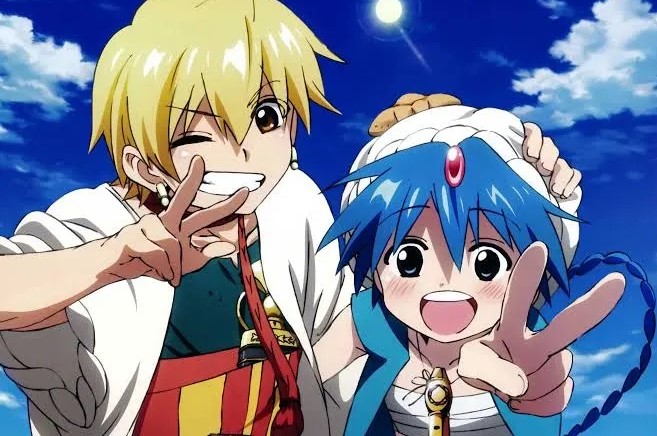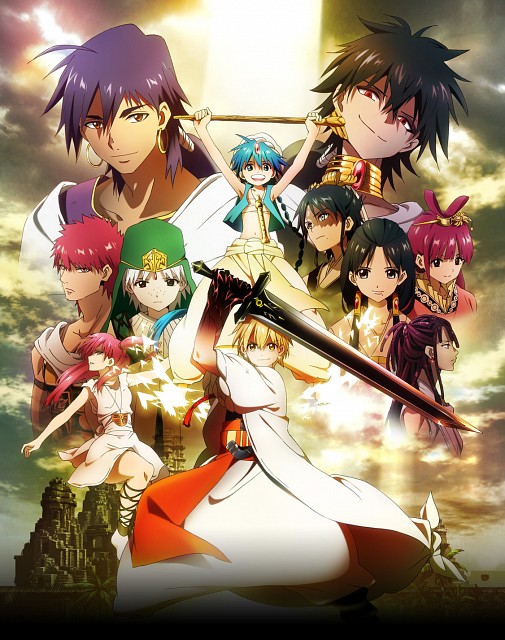Magi: Labyrinth of Magic hooks you with its vibrant fantasy world, cheerful characters, and classic shonen anime energy. Roughly inspired by a collection of short stories of 1001 Arabian Nights, it pulls from Arabian influence, mixing magic, bad-ass weapons, and exploration together. And despite appearances, Magi is not for kids. This colorful anime deals with mature themes such as slavery, politics, and philosophical ideas, and does depict casual nudity.
Individuals are guided by magi, powerful magicians, to conquer giant dungeons. Once they have been captured, a powerful spirit known as Djinn will select an item that belongs to them as a metal vessel to reside in. This turns the owner into a king’s vessel, marking them as a potential king.
Aladdin, our young main character, is on a soul searching journey to find out who he really is. His past is shrouded in mystery as he explores the world and meets new people; shedding light on his past and identity. He is accompanied by his friend Ugo, a Djinn who resides in Aladdin’s flute. Their close relationship is a staple for how Aladdin builds connections, since Ugo not only aids Aladdin in battle, but also guides him on his path in life.
He then meets Alibaba, who at first is an ass-kisser to anyone with authority, however his character quickly takes on new shapes and grows considerably. Alibaba is a prince who abandoned his kingdom. He confronts his shame, and works towards aiding his kingdom to develop in a way that’s best for the citizens. Then there’s Morgiana, a Fanalis slave girl who hails from an elite tribe of fighters sought after as slaves. Morgiana’s arc is particularly engaging because she’s often forced to confront her trauma from when she was a slave.
Magi breakdown
Magi does a fantastic job of balancing the dense and dark plot with emotional respite. When Aladdin and Alibaba conquer their first dungeon, they see first hand the impact slavery has. They are forced to face their own demons and overcome them to conquer the dungeon. After the dungeon has been captured, Aladdin is teleported to a field where he meets a nomadic tribe. It’s heart-warming as Aladdin connects with them on an emotional level, creating deep relationships and roots.
The artistic direction is bright and colorful, which adds visual contrast to the “light vs dark” conflict that appears in the show. The actions of Aladdin and his friends come from the heart, they empathize with others, and are striving for the ideal outcome for everyone. Whereas minor villains, like Judar, love nothing more than war and wish to sow the seeds of discord among people. Making the differences between the heroes and villains evident.
The character designs are distinct, even the Fanalis who all have red hair and were given similar visuals, are individualistic. Each character design compliments the world, and is believable in that universe. The fight scenes are well animated and fluent. Magi is able to convey the impact of hand-to-hand combat, magic, and weapons.
Magi puts a lot of effort into world building to give the viewer a sense of adventure. There are many different countries, each with their own culture. From a rural clan that treasures family above all else, to a country that has revolutionized their economy through magic tools. But every utopia has a dystopia, you never know what mysteries hide in the underbelly of each country.

I accept all those who will stand against such inequalities.” – Sinbad
To contrast the art, the soundtrack feels very bland. Musical cues and themes provide accurate moods for what’s unfolding on screen but it’s not anything special, just basic background music. However, the first opening song “V.I.P.” by SID is an absolute banger. Within mere seconds the exhilarating classic shonen vocals hit your ears, and you just know you’re bound for a magical adventure. The song floods you with hype and excitement for the battles that are going to unfold in the world of Magi, and suits the overall anime perfectly.
The anime takes a few different turns from the manga, but the changes are generally neutral because it stays mostly accurate. Nearly all of the running gags in the series are shelved mid-way into the manga, and the Arabian influence is totally overhauled towards the end. The manga ending also feels rushed considerably, and this does affect the quality. Due to the probable lack of an anime conclusion, you’ll want to read the manga to see the end.
Magi is an easy to digest battle/magic shonen, with a giant cast of complex characters, full of vices and virtues that affect the choices they make. Each character has their own motivations, and rich histories. The world is expansive, you’re always being introduced to new settings, which keeps the show fresh and feeds into the sense of adventure. Magi offers us diverse characters along with world exploration and mysteries to uncover for all the adventurous viewers.
Seasons, watch order, spin-off
Magi has a first season called Magi: Labyrinth of Magic and a second season Magi: The Kingdom of Magic. After that, there’s also a prequel spin-off series Magi: Adventures of Sinbad starring Sinbad, an accomplished dungeon capturer. There are speculations online of a third season coming early 2022, but nothing from a credible source. Most fans of Magi have given up on a third season being released.
You can watch Magi: Labyrinth of Magic now on Funimation and soon on Crunchyroll as well after their recent content merger.
Title: Magi: Labyrinth of Magic
Studio: A-1 Pictures
Producer: Aniplex, Dentsu, Shogakukan-Shueisha Productions, Mainichi Broadcasting System, Movic, GYAO!
Director: Koji Masunari
Creator: Shinobu Ohtaka
Rating: PG-13





